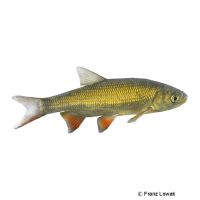Ide (Leuciscus idus)
| Ide Leuciscus idus | |
|---|---|
| Name | Ide |
| Name Lat. | Leuciscus idus |
| Family | Minnows |
| Family lat. | Leuciscidae |
| Order | Carps |
| Order lat. | Cypriniformes |
| Origin | Europe, Asia |
| Habitat | Rivers, lakes |
| Diet | Omnivore |
| pH | 7.0-7.5 |
| Behavior | Peaceful |
| Keeping | Group |
| Care Level | Easy |
| Reproduction | Egg scatterer |
| Breeding | Simple |
| Life Span | 8-10 years |
| Protection | No |
| Metric Units | |
| Size | 30-80 cm |
| Temperature | 4-22 °C |
| Hardness | < 15 °dH |
| Aquarium | Ponds |
| US Units | |
| Size | 12"-31" |
| Temperature | 39-72 °F |
| Hardness | < 267 ppm |
| Aquarium | Ponds |
Distribution and habitat
The Orfe's natural range extends east from the Rhine to Siberia and north of the Alps to the Arctic Circle. They live in oxygen-rich, slow-flowing lowland rivers and lakes, where they prefer to stay near the shore near the water surface in shoals.
Maintenance
A suitably large pond is required for keeping. The pond should be furnished with pond, floating and especially oxygenating underwater plants (water milfoil, water plant, hornwort, etc.), large river pebbles as well as a substrate of sand and round-grained gravel and offer plenty of free swimming space.
No ammonia, ammonium or nitrite should be detectable in the water, and the nitrate value should not exceed 100 mg/l. To ensure the water quality and oxygen content, a filter adapted to the water volume should not be missing.
Diet
They are omnivorous, feeding on insects, small crustaceans, fish spawn, snails, mussels and soft plant parts. Approach food (mosquitoes) is also particularly readily taken from the water surface. The food supply consists of live or frozen cyclops, daphnia, mysis, artemia and mosquito larvae or a frozen food mixture. High quality floating pond food (granules, pellets, flakes) is also readily accepted. In addition, plant-based dry food (kelp, spirulina) should be fed occasionally
Behaviour and compatibility
They are lively, swarming fish that do not show any aggressive or incompatible behavior. At least 5, but preferably much more Orfen should be kept together. A socialization with other pond fish is well possible. However, fish that are too small are considered food
In principle, only mutually compatible fish species with similar demands on water quality and water temperature may be socialized.
Reproduction and breeding
The sexes are difficult to distinguish. The males are somewhat slimmer and have a spawning rash on the head and forebody at spawning time.
Breeding is only successful in very large ponds. In the spawning season, from April to June, the female lays the sticky eggs in shallow water on gravel or plants. After 2-3 weeks, the fry hatch and feed on zooplankton.
Important
Orfen are very suitable for pond keeping and since they mostly stay on the water surface they are easy to observe. They are bred in the color variants blue, gold and silver
If they are overwintered in the pond, a sufficient depth and oxygen supply (filter, oxygen dispenser, ice free holder) must be ensured
At temperatures below 8-10 °C the metabolism of the fish slows down and food is no longer accepted, feeding must be stopped accordingly. If the temperature drops further, they hibernate near the bottom. In spring, with rising temperatures, feeding can slowly be resumed. Feeding may also be necessary during prolonged warm periods in winter.
The well-being of the fish should be monitored regularly. A regular partial water change, according to the pond size is recommended, even if the pollutant load has not yet reached the upper limit. Sudden changes in water quality should be avoided. Newly introduced fish must be accustomed slowly to the water in the pond
Further literature can be found in your pet store.
References
Text: Werner Winter; Image: Franz Lowak
Source: BMELV (1998): Tierschutzgutachten - Haltung von Zierfischen (Süßwasser); RIEHL & BAENSCH (2006): Aquarien Atlas Bd. 1, Mergus Verlag; ENGELMANN (2005): Zootierhaltung - Tiere in menschlicher Obhut: Fische; Harri Deutsch Verlag
- Gemäß § 21 Abs. 5 Tierschutzgesetz idgF
